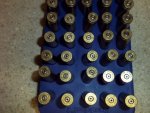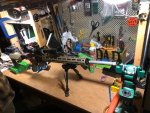You have been posting this for years to back up your statement that bolts with a .136 recess are stronger but the .136 recess bolts are weaker. There is less support on the back of the lugs, only 7-8% but still weaker not stronger. Take Maxim Firearm bolts as an example, all of his bolts(5.56, 6.8. Grendel. 7.62x39) like mine are made from the same material and go through the same heat treat process. The bolts with a .124 recess have stronger lugs. Now you say the extractors are stronger with this drawing. Depends on who designed the bolt. If making the bolts from scratch the simple thing is to move the extractor pivot pin forward .010" instead of moving the groove on the extractor forward.
You know the extractors AA used can be used on 7.62x39 bolts. Same size extractor hook, no less metal and same strength. R-Guns use to sell them, Black Rifle Arms in Fla still sells them. Instead of a thinner dished out area on each side of the stiffener lug they are flat and actually thicker to give more strength to the hook.
BRA-extractor
I know you already know this but extractor strength is a totally different conversation than bolt strength. I have
never made the argument that a deeper bolt face depth is stronger than a shallower bolt face depth, all approaches to the lug support being the same.
I’m really not sure how someone could confuse the 2 parts.
The strongest 7.62x39 bolt that I’m aware of is made from AerMet by LMT. They use a .125” face depth since so many companies went with that despite Colt’s work on the 7.62x39 Sporter.
Guess what happens even to those extractors?
I’ve also seen claims from someone who either worked for or was a dealer for BHW say how they never saw any problems with .125” bolt breaking extractors (based on limited customer feedback). The next day, a customer asked what to do about his broken extractor from one of those bolts.
Anyone that has shot 7.62x39 in compressed high volume from AR-15s will tell you that bolts and extractors are expendable items for them.
There are people who are experiencing extractor failure at 50, 90, and 200rds with 7.62x39 AR-15s within the past year.
There are very few companies who have done legitimate high-volume pyramid testing with 7.62x39 in AR-15s starting with 100,000rds across at least 10 rifles. Colt is the only one I’m aware of that did their due diligence with outside funding for the program decades ago.
Another thing I’m seeing is that a lot of companies are installing O rings around the extractor springs by default, not aware that this was a band-aid for M4A1s shooting suppressed (and the resulting excess cyclic rate-induced FTExtract malfunctions). The excess extractor tension adds stress to the extractor lip when going into battery, and contributes to reduced extractor life.
As a rule, I don’t let extractors near my bolts with those O rings in them. I prefer a relaxed extractor that only has enough tension to do its job in an optimum gas system configuration (correct port diameter for the length-unlike the MLGS .223 Wylde barrel you sold me with a .094” port that recoils so violently that it broke one of my LPVO ocular pieces loose). The Mil-Std spring and buffer insert have plenty of tension.
As to the bolt strength, there are minor radius changes that can be made to the inner circumference of the wall and bolt face, as well as the lugs to re-gain lug root strength. You already know all about that.
Given the sheer volume of steel case that has been flowing into the market over the past several years, we should be hearing about all kinds of 6.5 Grendel bolt failures. There have been extractor failures for sure though, when companies have allowed their extractor manufacturing process to get out-of-line. I also see people nitriding extractors, which encourages embrittlement.
A have a good friend who, along with his family and friends, seem to be breaking Grendel extractors at 1000rds shooting Wolf Steel case. Every one of those extractors had the O ring in them.
Another buddy of mine built a 12.5” Grendel, in addition to 16” and 20” rifles. He used JP bolts for all. Last time I caught up with him, he had over 8700 rounds through the 12.5” in his log book. It has had mostly 123gr ELD-M through it. All of it has been suppressed. No failures.
I’ve been shooting Grendel regularly for 11 years now across multiple rifles of varying gas system and barrel lengths, with all kinds of hand loads and factory ammo. I have yet to break anything. I think I even herniated a disc moving some of my moving boxes full of Grendel brass, so this isn’t one of those cases where some guy shoots a few hundred rounds, which grow into thousands in his mind.
To date, the only bolts I’ve ever broken in an AR-15 have been 5.56 bolts, and that was shooting really compressed high-volume in tortuous sessions, with CLGS 16” after 10,000rds.
For a production extractor to have enough lip material for a .125” face depth, you really need a wider extractor (what POF did on the Revolution .308 Win), which means different bolt and barrel extension design. Not even LMT (who has forgotten more about sound production and design related specifically to the AR-15), has been able to make a reliable .125” face depth .441” case head diameter bolt extractor.










